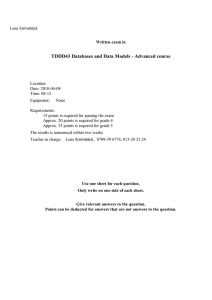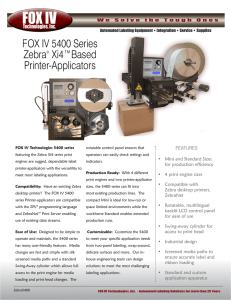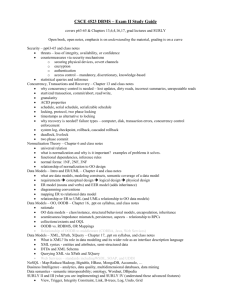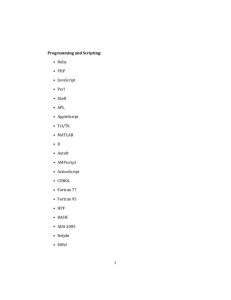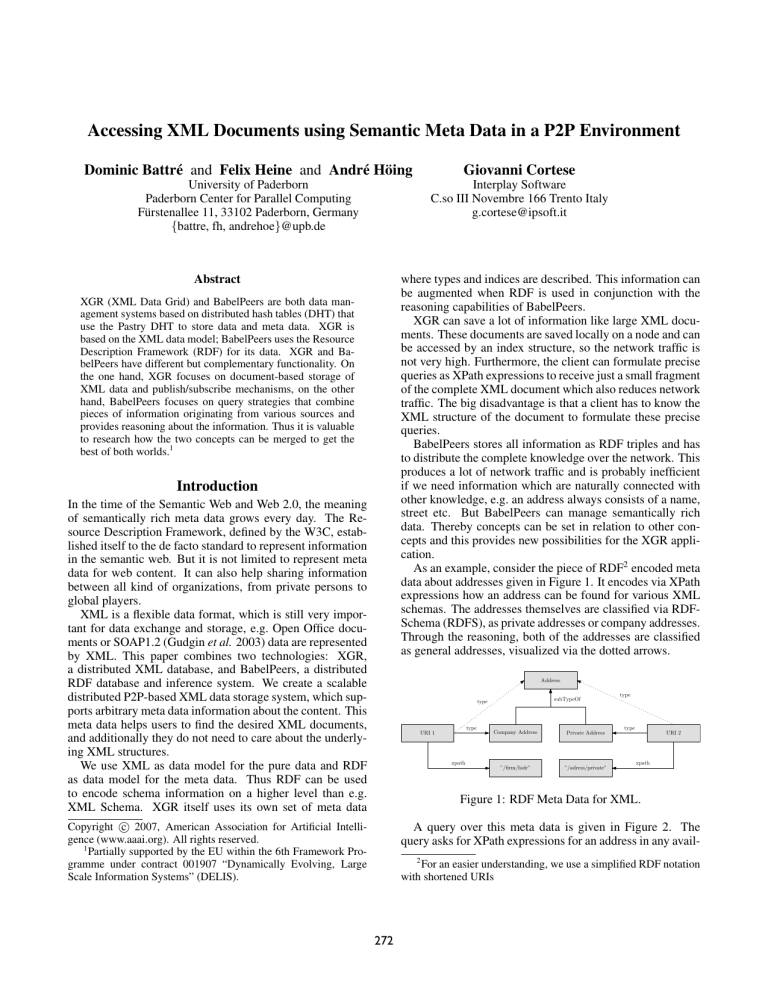
Accessing XML Documents using Semantic Meta Data in a P2P Environment
Dominic Battré and Felix Heine and André Höing
Giovanni Cortese
University of Paderborn
Paderborn Center for Parallel Computing
Fürstenallee 11, 33102 Paderborn, Germany
{battre, fh, andrehoe}@upb.de
Interplay Software
C.so III Novembre 166 Trento Italy
g.cortese@ipsoft.it
where types and indices are described. This information can
be augmented when RDF is used in conjunction with the
reasoning capabilities of BabelPeers.
XGR can save a lot of information like large XML documents. These documents are saved locally on a node and can
be accessed by an index structure, so the network traffic is
not very high. Furthermore, the client can formulate precise
queries as XPath expressions to receive just a small fragment
of the complete XML document which also reduces network
traffic. The big disadvantage is that a client has to know the
XML structure of the document to formulate these precise
queries.
BabelPeers stores all information as RDF triples and has
to distribute the complete knowledge over the network. This
produces a lot of network traffic and is probably inefficient
if we need information which are naturally connected with
other knowledge, e.g. an address always consists of a name,
street etc. But BabelPeers can manage semantically rich
data. Thereby concepts can be set in relation to other concepts and this provides new possibilities for the XGR application.
As an example, consider the piece of RDF2 encoded meta
data about addresses given in Figure 1. It encodes via XPath
expressions how an address can be found for various XML
schemas. The addresses themselves are classified via RDFSchema (RDFS), as private addresses or company addresses.
Through the reasoning, both of the addresses are classified
as general addresses, visualized via the dotted arrows.
Abstract
XGR (XML Data Grid) and BabelPeers are both data management systems based on distributed hash tables (DHT) that
use the Pastry DHT to store data and meta data. XGR is
based on the XML data model; BabelPeers uses the Resource
Description Framework (RDF) for its data. XGR and BabelPeers have different but complementary functionality. On
the one hand, XGR focuses on document-based storage of
XML data and publish/subscribe mechanisms, on the other
hand, BabelPeers focuses on query strategies that combine
pieces of information originating from various sources and
provides reasoning about the information. Thus it is valuable
to research how the two concepts can be merged to get the
best of both worlds.1
Introduction
In the time of the Semantic Web and Web 2.0, the meaning
of semantically rich meta data grows every day. The Resource Description Framework, defined by the W3C, established itself to the de facto standard to represent information
in the semantic web. But it is not limited to represent meta
data for web content. It can also help sharing information
between all kind of organizations, from private persons to
global players.
XML is a flexible data format, which is still very important for data exchange and storage, e.g. Open Office documents or SOAP1.2 (Gudgin et al. 2003) data are represented
by XML. This paper combines two technologies: XGR,
a distributed XML database, and BabelPeers, a distributed
RDF database and inference system. We create a scalable
distributed P2P-based XML data storage system, which supports arbitrary meta data information about the content. This
meta data helps users to find the desired XML documents,
and additionally they do not need to care about the underlying XML structures.
We use XML as data model for the pure data and RDF
as data model for the meta data. Thus RDF can be used
to encode schema information on a higher level than e.g.
XML Schema. XGR itself uses its own set of meta data
Address
subTypeOf
type
type
URI 1
xpath
type
type
Company Address
Private Address
”/firm/fadr”
”/adress/private”
URI 2
xpath
Figure 1: RDF Meta Data for XML.
c 2007, American Association for Artificial IntelliCopyright gence (www.aaai.org). All rights reserved.
1
Partially supported by the EU within the 6th Framework Programme under contract 001907 “Dynamically Evolving, Large
Scale Information Systems” (DELIS).
A query over this meta data is given in Figure 2. The
query asks for XPath expressions for an address in any avail2
For an easier understanding, we use a simplified RDF notation
with shortened URIs
272
DHT Networks
able XML document. Through the RDFS reasoning explained in the section “BabelPeers”, the query will yield
both ”/firm/fadr” and ”/address/private”.
To understand the employed technologies, BabelPeers and
XGR, we give a short introduction to DHT-networks.
A distributed hash table (DHT) is comparable to a regular
hash table with efficient insert and lookup operations, except
that the ID space of a DHT is distributed between the nodes
of a peer-to-peer network. This network is able to route insert and lookup requests to those nodes which are responsible for the respective fractions of the ID space in O(log N )
routing steps with high probability, where N is the number
of nodes in the network.
Each node of the peer-to-peer network is assigned a
unique position in the ID space. In case of Pastry (Rowstron
& Druschel 2001), the DHT used by BabelPeers and XGR,
the ID space is a ring 0 . . . 2128 − 1. The concrete distribution of IDs to nodes depends on the DHT implementation.
In Pastry, the IDs of the ring that are closest to a node’s position are mapped to this node. In Chord (Stoica et al. 2003),
those IDs that follow a node’s position on the ring up to the
following node are mapped to this node. Additionally, Pastry provides some other services, e.g. replication.
Like in a regular hash table, we insert attribute value pairs.
The network derives the hash value of the attribute and sends
both, attribute and value, to the node which is responsible for
the hash value. The lookup operation works similarly. We
hash the attribute and send the lookup to the node which is
responsible for the hash value. Figure 3 presents an example,
how we insert an RDF triple in BabelPeers. This figure is
described below in detail.
type
Address
xpath
?locationXPath
Figure 2: Query for RDF Meta Data.
By managing meta data in RDF triples we gain the possibility to generalize queries and to hide the possibly complex
XPath structure behind clearly defined terms.
This paper is structured as follows. The next section gives
an overview about the related work. The following sections, “DHT Networks”, “BabelPeers”, and “XGR”, introduce our researches, which this paper combines. The description about the integration and how the different applications are connected is given in section “Integrating XGR
and BabelPeers”. That section also shows the advantages resulting from the integration. The last section “Conclusion”
summarizes the results and gives ideas for further use cases.
Related Work
The two main themes of this paper are P2P-based data management and the possibilities, which we gain by using a semantic description language as RDF. So the related work
limits to these.
We survey existing approaches related to the field of P2P
based data management which have schema management
components. The survey does not aim to be exhaustive, we
rather want to introduce the projects Hyperion (Arenas et
al. 2003) and Piazza (Halevy et al. 2003), which represent
different approaches to the problem.
The origins of both are stand-alone data integration systems for relational or XML-based data. Hyperion and Piazza can be seen as a natural evolution step of these systems,
moving from a single, centralized mediated schema towards
an arbitrary number of peers where each peer runs a local
data integration system which integrates both its own data
and data from the other peers. Their basic assumption is
quite similar: each peer holds a collection of physical relations and associated schema information. It has furthermore
a mediated schema, which represents a homogenous view
including the peer’s own relations and the mediated schema
of the neighbors of this peer. Both systems assume the existence of mapping information. They differ in the types of
supported mappings.
Both systems use an unstructured P2P network. Thus
each peer has a limited set of connections to neighboring
peers, and might store some peer mappings relating its data
to the neighbors data.
RDFPeers (Cai et al. 2004) and Atlas (Koubarakis et al.
2006) are based on structured P2P networks, in particular
distributed hash tables, the same kind of network BabelPeers
uses. They also work with RDF and distribute triples in the
same way. The big disadvantage is that they do not support
RDF Schema reasoning.
BabelPeers
Generally, BabelPeers can not only manage meta data, but
also other information, given as RDF triples. An RDF triple
can be regarded as a sentence, which consists of subject,
predicate, and object. The knowledge can be seen as a directed graph. The subjects and objects are the vertices of the
graph and for every triple, there is one edge, labeled with the
predicate, directed from the subject to the object.
BabelPeers is peer-to-peer based and every peer shares
his knowledge with all other nodes. The network fits all
these parts together into one big knowledge base which is
available for every peer. The following paragraphs describe
how this knowledge sharing works.
After the distribution of the RDF triples, each triple is
saved on three different peers, identified by the hash values
of the triple’s elements: hash(Subject), hash(P redicate)
and hash(Object). Figure 3 shows a five node Pastry network and how we insert an RDF-Triple.
By distributing the RDF triples that way, it is guaranteed
that all triples, that share a common URI at arbitrary positions merge on a single node in the network. This is a
precondition for the RDFS inference rule system, described
below. Furthermore every triple is accessible already, if we
only know one of the three elements.
Figure 4 presents the view, which each node has to the
network. The peers do not know where triples are stored,
even the triples, which they have inserted. They only calculate the hash value and send a lookup request to the network.
273
0 / 2128
now, just a subset of SPARQL is available, but it fulfills our
needs. A query consists of a set of triples including variables. The peer tries to find a binding for these variables by
collecting all possible candidates for every query triple and
processing a pattern matching as the second step. Finally
the node sends all valid bindings back to the client. Figure 5
shows the query, seen in Figure 2, as SPARQL code. More
detailed information about the query evaluation can be found
in the paper (Heine 2006).
(Company Address, subClassOf, Address)
(Company Address, subClassOf, Address)
Node 1
Node 2
296
232
Node 3
Node 5
(Company Address, subClassOf, Address)
SELECT ?indexPath WHERE {
?var type Address .
?var xpath ?indexPath .
}
Node 4
Object 1: hash(Company Address)
Object 2: hash(subClassOf)
264
Object 3: hash(Address)
Figure 3: Inserting RDF-Triples in a Pastry Network
Figure 5: Example – SPARQL query
So each node has the same way to query knowledge and so
the network seems to provide one big knowledge base that
incorporates the complete knowledge of each peer. So it
is possible to infer new triples (information) which was not
possible without sharing information. In Figure 4, this is
shown by the dotted edges.
Node A
We have shown that BabelPeers combines the semantic
knowledge of every single peer to one knowledge base, accessible for all nodes. Additionally, it generates the complete derivable knowledge and makes it available networkwide. Altogether it is the right choice to manage a huge
number of RDF triples and to use this information in a semantic context.
Node B
XGR
XGR is peer-to-peer based, too, but aims for different goals
than BabelPeers. It realizes a distributed database for XML
documents, relying on storage resources provided by a network of collaborating peers. Depending on the application
scenario, XML data can be stored in a local storage at the
peer which performed the insert operation, and only indices
are stored in the DHT-based storage, but it is also possible to
store both, data and indices, in the network, e.g., for replication purposes.
An XGR datatype defines one kind of document with a
specific root element (set by the xgr:id-tag). It furthermore specifies a primary key (set by the xgr:pkey-tag)
that can be used to address one specific XML document.
Further indices can be defined by the xgr:index-tag. Indices allow efficient lookups of XML nodes (addressed by
XPaths) that store certain values. Figure 6 shows an example datatype definition of an address.
Network
Node D
Node C
Figure 4: Sharing knowledge with BabelPeers
The RDFS specification gives us a set of inference rules
to extend the explicit RDF knowledge. Each node executes a
forward chaining algorithm to generate all derivable knowledge by using this RDFS rule set. Most of the RDFS rules
map a single triple to a new one, but some rules contain two
triples in the precondition. This is no problem, because of
the dissemination described above. There is always a single
node which handles all triples of a specific URI. A closer
look to the rules shows that this dissemination suffices to
fulfill all rule preconditions.
Figure 1 shows an RDF reasoning example. We derive a
new triple, which states that the “URI 1” which is a “Company Address” is also an “Address”. This new triple will
be distributed over the network and so the derived information is available for all other nodes. So the inference system
works without generating a lot of network traffic. Our paper
(Battré et al. 2006) describes this in detail.
Clients can connect to any peer and pose questions formulated in SPARQL. They connect via a TCP connection. Until
<xgr:datatype xmlns:xgr="XGRSchema">
<xgr:id>ns:address</xgr:id>
<xgr:pkey>ns:id</xgr:pkey>
<xgr:desc>Address</xgr:desc>
<xgr:index>
<xgr:name>name</xgr:name>
<xgr:path>
/ns:address/ns:name
</xgr:path>
</xgr:index>
</xgr:datatype>
Figure 6: Example – datatype definition of an address
274
In this example, every address data item has to start with
an ns:address-tag. The xgr:pkey-tag specifies the
primary key, ns:id, used to build the primary index. Furthermore we can define further indices by using XPath expressions inside the xgr:index-tag. In this example, the
name is a second index.
After registering the datatype above, the system is ready
for inserting addresses. Figure 7 shows an example address
XML document, which represents the address of our institute.
by this integration. The second subsection then shows how
a new client uses the potential of the XGR-BabelPeers application.
Combining XGR and BabelPeers
Both applications are based on the Pastry DHT network. So
it is pretty easy to combine them without causing great overhead. Every peer has to start a single Pastry (see section
“DHT Networks”) node and connect to the network over
an already integrated bootstrap node. Then BabelPeers and
XGR simply register themselves at this node. From then on,
they can exchange messages with other XGR-BabelPeers
applications. The message routing is handled by Pastry. The
new client application can connect to both applications and
can send queries in SPARQL for BabelPeers and XPath for
XGR. Figure 8 shows the new combined network. In this
example, there are three companies, that want to share their
address books and perhaps several other XML documents
for better collaboration. Each company has its own XML
format for its address books and none wants to change its
XML-Schema. XGR-BabelPeers combines all information
with the help of a smart meta data structure without any
changes in the XML documents.
<ns:address xmlns:ns="AddressSchema">
<ns:id>1</ns:id>
<ns:name>PC2</ns:name>
<ns:street>
Fuerstenallee 11
</ns:street>
<ns:city>Paderborn</ns:city>
<ns:zip>33102</ns:zip>
</ns:address>
Figure 7: Example – address insertion
XGR provides means to formulate queries (e.g. for addresses of named entities) as simple XPath expression and
returns the appropriate XML fragments. We defined two indices above, the primary key ns:id and a second index
ns:name. For fast querying, we can use these two indices, which are hold distributed. A DHT-lookup gives us
the nodes where we find relevant XML fragments. XGR
provides also the possibility to look for XPath expressions,
which are not indexed. However, the network has to ask
every node for adequate information and so this is very expensive and slow.
XGR offers different possibilities for data retrieval.
The user can simply use XPath expressions for describing the desired information (see paragraph above).
For our running example, the query XPath expression
/ns:address[ns:name="PC2"] returns the PC2 address we added above, and alternatively /ns:address returns all known addresses. Furthermore, XGR implements
a publishing/subscriber system (Emiliano Casalicchio, Federico Morabito, Giovanni Cortese, Fabrizio Davide 2005).
The user will receive an update, if a certain event happens
on the observed elements, also defined by a XPath expression. So the user is always informed about the current status
of an entry or about new interesting information added to
the database. This is not very interesting in our example, but
when using XGR, e.g., for observing the progress in a workflow or following a product through its fabrication process,
it becomes more relevant.
company A
company B
XGR
BabelPeers
company C
Client
SPARQL Result
XML
SPARQL
XPath
Figure 8: XGR and BabelPeers integration
First every company has to insert its meta data as RDF
into the network. Therefore all companies have to agree on
a generally accepted namespace for different concepts. In
our introductory example (see Figure 1) the concepts “Company Address”, “Private Address” and “Address” are given.
With these concepts, the structure of the inserted address
XML documents can be described by every company itself.
Assume that company A saves all information about a firm
inside one big XML document with root tag firm. Figure 9 shows an extract of the meta data company A adds
to XGR-BabelPeers. It defines the semantics for company
addresses, which can be found in the database at the path
/firm/fadr. In addition, addresses naturally contain the
city, zip, street, etc. and it should be possible to use the information for finding a particular firm. Again, no company
needs to change its own XML format, it only has to define
where it saves information about the concepts. Therefore
Integrating XGR and BabelPeers
The aim of this paper is to create a distributed XML database
which uses semantic meta data. The combination of XGR
and BabelPeers offers a solution to this problem. The first
subsection describes how we combined the two applications
on the DHT network and presents the advantages, we gain
275
SELECT ?indexPath ?filter WHERE {
?addr type CompanyAddress .
?addr xpath ?indexPath .
?addr contains ?city .
?city type City .
?city xpath ?filter .
}
the inserted meta data describes where to find this additional
concepts relative to the “Company Address” XPath.
type
company addresses
(company A)
CompanyAddress
xml db index
xpath
”/firm/fadr”
contains
type
Zip
XPathPattern: ?indexPath[?filter="Paderborn"]
contains
type
xpath
”zip”
City
Figure 10: Example – query
xpath
”city”
?filter = "city"
The second part of the query is an XPath expression,
which describes how to use the variable bindings. We simply
substitute the variables and get the following XPath expression:
Figure 9: Extract of the address meta data (company A)
Now assume, Company B has a completely different
XML structure for saving addresses. E.g. it has a lot of XML
documents and every document contains just one address.
By inserting their own XPaths to the semantic concepts, the
information can be queried very easily for all participants
without knowing the XML structure.
After designing the meta data and adding it into the BabelPeers part, the second step is to insert the XML documents into the XGR part. Therefore, every company has
to map metadata and the datatypes with each other. The
datatypes include, as described above, the information about
the indexing structure, which will be distributed, and only
indexed paths can be found efficiently. It would be an advantage if all companies defined the same indexing structure, and accordingly use indices which match with the usually performed queries. E.g. if we often look for addresses
in a given city, it makes sense, if we have an index on the
addresses or even a second index directly to the cities inside
the addresses. If we describe these indices by defining RDF
triples, which mark the desired concepts as an index, instead
of XPath expressions, we can use the meta data to generate
the datatype definitions even automatically (see dotted bordered concept in Figure 9). After this, we just insert all XML
documents into the database and are ready to query all data
in the same way.
/firm/faddr[city="Paderborn"]
Now the client uses this to query XGR and gets the desired
information. For another company, the path can look completly different. Perhaps they have sorted their addresses
by cities (the city tag is a parent of the address tag). The
SPARQL query returns another result for the company XML
structure and the new path expression probably looks like the
following (the address tag is defined as an index):
/addresses/city/address/
[../@name="Paderborn"]
The client poses this query to the XGR system, too, and
merges the two results before returning one complete answer
to the user.
Additionally, the combination of these two technologies
also offers the possibility to query more general concepts,
which can not be found directly in the XML structure. Figure 1 and Figure 2 introduced this. Imagine a database including different kinds of addresses with different datatypes:
employee addresses, customer addresses, distributor addresses and so on. Now you want to inform everyone per
eMail that something very important will happen. Without
using meta data, you had to look at each datatype definition and create special queries for every kind of addresses.
Now you can do this by defining a single query, because the
meta data states that every kind of an address is a subclass
of the concept “Address”. BabelPeers uses this information
to derive that every “Company Address” is an “Address”,
too. The query is shown in Figure 11. This query filters all
addresses, which contain information about email addresses
and returns this information.
Certainly, other query options like the publish and subscriber system can also be used after fetching meta data.
A different use case of XGR-BabelPeers is, if several
companies share parts of their data, sometimes it could be
hard to know what kinds of information are accessible. If the
meta data information are up to date, a query for all concepts
or even a graphical interface which presents the class hierarchy in a clear way, can help to solve this problem. Later,
such a GUI can be extended, so that queries can be formulated by drag and drop or other simple interfaces.
Querying XGR-BabelPeers
In the next few paragraphs, we show how we design the new
queries for hiding the two systems from the user.
We assume that normally the queries consist of a part
which is looking for a XML fragment identified by an index and additionally one or several filters which select the
desired data records. Figure 10 presents an example query
which asks for all company addresses located in “Paderborn”.
First we have to compose a SPARQL query to find the relevant concepts and appropriate XPath expressions. In detail,
we search for a company address which contains information about the city. As result, we get a list of valid bindings
for the variables index and filter.
For the example shown in Figure 9, the bindings would be
as follows:
?indexPath = "/firm/faddr"
276
SELECT ?indexPath ?rpath WHERE {
?addr type Address .
?addr xpath ?indexPath .
?addr contains ?email .
?email type EMail .
?email xpath ?rpath .
}
• In connection with the Semantic Desktop idea the system
provides the possibility to save arbitrary information and
the related semantic meta data. With the help of an adequate API, this data can be accessed from different desktop applications.
At the moment, we implemented a prototype which combines both applications on the same pastry node. A very
simple client has been created to test the integration but no
evaluation has been done yet. This will be future work.
XPathPattern: ?indexPath/?rpath
Figure 11: Example – general query
References
Arenas, M.; Kantere, V.; Kementsietsidis, A.; Kiringa, I.;
Miller, R. J.; and Mylopoulos, J. 2003. The Hyperion
Project: From Data Integration to Data Coordination. SIGMOD Record 32(3):53–58.
Battré, D.; Heine, F.; Höing, A.; and Kao, O. 2006. On
Triple Dissemination, Forward-Chaining, and Load Balancing in DHT based RDF stores. In Databases, Information Systems and Peer-to-Peer Computing (DBISP2P
2006).
Cai, M.; Frank, M.; Pan, B.; and MacGregor, R. 2004.
A Subscribable Peer-to-Peer RDF Repository for Distributed Metadata Management. Journal of Web Semantics: Science, Services and Agents on the World Wide Web
2(2):109–130.
Emiliano Casalicchio, Federico Morabito, Giovanni
Cortese, Fabrizio Davide. 2005. A novel adaptive contentbased subscription management system. Technical report,
DELIS – Dynamically Evolving, Large-Scale Information
Systems.
Gudgin, M.; Hadley, M.; Mendelsohn, N.; Moreau, J.-J.;
and Nielsen, H. F. 2003. Soap version 1.2. http://
www.w3.org/TR/soap12.
Halevy, A. Y.; Ives, Z. G.; Suciu, D.; and Tatarinov, I.
2003. Schema Mediation in Peer Data Management Systems. In 19th International Conference on Data Engineering (ICDE).
Heine, F. 2006. Scalable P2P based RDF Querying. In
InfoScale ’06: Proceedings of the 1st international conference on Scalable information systems, 17. New York, NY,
USA: ACM Press.
Koubarakis, M.; Miliaraki, I.; Kaoudi, Z.; Magiridou, M.;
and Papadakis-Pesaresi, A. 2006. Semantic Grid Resource
Discovery using DHTs in Atlas. In 3rd GGF Semantic Grid
Workshop.
Rowstron, A., and Druschel, P. 2001. Pastry: Scalable, Decentralized Object Location, and Routing for Large-Scale
Peer-to-Peer Systems. Lecture Notes in Computer Science
2218:329+.
Stoica, I.; Morris, R.; Liben-Nowell, D.; Karger, D.;
Kaashoek, M. F.; Dabek, F.; and Balakrishnan, H. 2003.
Chord: A Scalable Peer-to-peer Lookup Service for Internet Applications. IEEE Transactions on Networking 11.
Conclusion
The goal of creating a system for managing XML documents
with the help of semantic meta data is realized by the combination of BabelPeers and XGR. Both are working on a scalable P2P network and so the system is ready to save a high
number of documents and the corresponding meta data.
We presented how we can use the advantages of XML and
RDF to combine our local documents with the distributed
knowledge base, available in the network. Every user is able
to access the data without reading big XML DTDs or similar
documents. Instead, he formulates the queries by using the
meta data and gets direct access to all available documents
containing relevant information.
The usage of the concepts presented in this paper creates
several advantages:
• Easy joining of completely differently structured XML
documents containing the similar information or parts of
them.
• Querying the information of the combined database by
posting simple semantically rich queries and not by writing difficult XPath expressions.
• Getting an overview over the saved information by
analysing the meta data.
This is just a beginning to use the advantages of both applications, so there are some unsolved problems. It is possible to define which semantic concept should be used as an
index for the datatype by using the meta data, but it is not
clearly defined whether the XPath is given as an absolute
path or a relative one. We can declare that all indices must
be given as absolute and all other concepts as relative paths.
Then we can build the query XPath expression by searching the matching index concept for a non index query in the
RDF graph, but we think that there can be better solutions.
The XGR-BabelPeers system is not only usable for companies sharing addresses. We can imagine many scenarios,
where it can help managing data. We only list a few of our
ideas:
• In the introduction, we mentioned that Open Office documents are written in XML. Thus, sharing Open Office
documents in a working community and tagging the documents with semantic meta data is possible.
• Combined with adequate access control mechanism it is
possible to build a great semantic network between users,
workgroups, or companies and sharing their knowledge.
277


